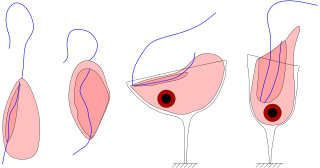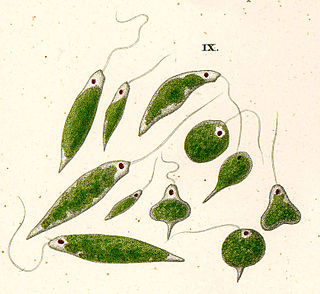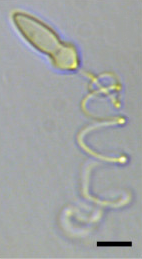Related Research Articles

Euglenozoa are a large group of flagellate Discoba. They include a variety of common free-living species, as well as a few important parasites, some of which infect humans. Euglenozoa are represented by four major groups, i.e., Kinetoplastea, Diplonemea, Euglenida, and Symbiontida. Euglenozoa are unicellular, mostly around 15–40 μm (0.00059–0.00157 in) in size, although some euglenids get up to 500 μm (0.020 in) long.

Excavata is an extensive and diverse but paraphyletic group of unicellular Eukaryota. The group was first suggested by Simpson and Patterson in 1999 and the name latinized and assigned a rank by Thomas Cavalier-Smith in 2002. It contains a variety of free-living and symbiotic protists, and includes some important parasites of humans such as Giardia and Trichomonas. Excavates were formerly considered to be included in the now obsolete Protista kingdom. They were distinguished from other lineages based on electron-microscopic information about how the cells are arranged. They are considered to be a basal flagellate lineage.

Stephanopogon is a genus of flagellated marine protist that superficially resembles a ciliate.

Calkinsia is a monotypic genus of excavates comprising the single species Calkinsia aureus. It lives in low-oxygen seafloor environments. It is not classified in any of the three well-known groups of the Euglenozoa, but is placed in its own group, the Symbiontida. Some authors have classified Calkinsia alongside Postgaardi, but Postgaardi has not been studied well enough to test this hypothesis.
Carpediemonas is genus of Metamonada, and belongs to the group Excavata. This organism is a unicellular flagellated eukaryote that was first discovered in substrate samples from the Great Barrier Reef. Carpediemonas can be found in anaerobic intertidal sediment, where it feeds on bacteria. A feature of this species is the presence of a feeding groove, a characteristic of the excavates. Like most other metamonads, Carpediemonas does not rely on an aerobic mitochondrion to produce energy. Instead, it contains hydrogenosomes that are used to produce ATP. This organism has two flagella: a posterior one used for feeding on the substrate, and an anterior one that moves in a slower sweeping motion. Carpediemonas is assigned to the fornicates, where similar Carpediemonas-like organisms are used in researching the evolution within excavates. Although Carpediemonas is a member of the metamonads, it is unusual in the sense that it is free-living and has three basal bodies.

Jakobids are an order of free-living, heterotrophic, flagellar eukaryotes in the supergroup Excavata. They are small, and can be found in aerobic and anaerobic environments. The order Jakobida, believed to be monophyletic, consists of only twenty species at present, and was classified as a group in 1993. There is ongoing research into the mitochondrial genomes of jakobids, which are unusually large and bacteria-like, evidence that jakobids may be important to the evolutionary history of eukaryotes.

The Gymnodiniales are an order of dinoflagellates, of the class Dinophyceae. Members of the order are known as gymnodinioid or gymnodinoid. They are athecate, or lacking an armored exterior, and as a result are relatively difficult to study because specimens are easily damaged. Many species are part of the marine plankton and are of interest primarily due to being found in algal blooms. As a group the gymnodinioids have been described as "likely one of the least known groups of the open ocean phytoplankton."

Percolomonas is a genus of free-living flagellate Heteroloboseans, forming a clade with Stephanopogon.

Diaphoretickes is a major group of eukaryotic organisms, with over 400,000 species. The majority of the earth's biomass that carries out photosynthesis belongs to Diaphoretickes.
Andalucia is a genus of jakobids.

Euglena viridis is a freshwater, single cell, mixotroph microalgae bearing a secondary chloroplast. Their chloroplast is bounded by three layers of membrane without a nucleomorph. Normally, it is 40–65 μm long, slightly bigger than other well-known Euglena species: Euglena gracilis.

Diplonemidae is a family of biflagellated unicellular protists that may be among the more diverse and common groups of planktonic organisms in the ocean. Although this family is currently made up of three named genera; Diplonema, Rhynchopus, and Hemistasia, there likely exist thousands of still unnamed genera. Organisms are generally colourless and oblong in shape, with two flagella emerging from a subapical pocket. They possess a large mitochondrial genome composed of fragmented linear DNA. These non-coding sequences must be massively trans-spliced, making it one of the most complicated post-transcriptional editing process known to eukaryotes.

The Polykrikaceae are a family of athecate dinoflagellates of the order Gymnodiniales. Members of the family are known as polykrikoids. The family contains two genera: Polykrikos and Pheopolykrikos.

Obazoa is a proposed sister clade of Amoebozoa. The term Obazoa is based on the OBA acronym for Opisthokonta, Breviatea, and Apusomonadida, the group's three constituent clades.
Rictus is a genus of Bikosea, a small group of unicellular flagellates, included among the heterokonts. The only species in the genus is Rictus lutensis.
Nanum is a genus of bicosoecids, a small group of unicellular flagellates, included among the heterokonts.
Petalomonas is a genus of phagotrophic, flagellated euglenoids. Phagotrophic euglenoids are one of the most important forms of flagellates in benthic aquatic systems, playing an important role in microbial food webs. The traits that distinguish this particular genus are highly variable, especially at higher taxa. However, general characteristics such as a rigid cell shape and single emergent flagellum can describe the species among this genus.
Heteronema is a genus of phagotrophic, flagellated euglenoids that are most widely distributed in fresh water environments. This genus consists of two very distinguishable morphogroups that are phylogenetically closely related. These morphogroups are deciphered based on shape, locomotion and other ultrastructural traits. However, this genus does impose taxonomic problems due to the varying historical descriptions of Heteronema species and its similarity to the genus Paranema. The species H. exaratum, was the first heteronemid with a skidding motion to be sequenced, which led to the discovery that it was not closely related to H. scaphrum, contrary to what was previously assumed, but instead to a sister group of primary osmotrophs. This suggests that skidding heteronemids can also be distinguished phylogenetically, being more closely related to Anisoma, Dinema and Aphageae, than to other species within Heteronema.
Postgaardia is a proposed basal clade of flagellate Euglenozoa, following Thomas Cavalier-Smith. As of April 2023, the Interim Register of Marine and Nonmarine Genera treats the group as a subphylum. A 2021 review of Euglenozoa places Cavalier-Smith's proposed members of Postgaardia in the class Symbiontida. As Euglenozoans may be basal eukaryotes, the Postgaardia may be key to studying the evolution of Eukaryotes, including the incorporation of eukaryotic traits such as the incorporation of alphaproteobacterial mitochondrial endosymbionts.
Bihospites is a genus of symbiontid euglenozoans characterized by the presence of two species of epibiotic bacteria on the cell surface. Bihospites cells are clear, biflagellated, and uninucleated, that range between 40–120 μm long and 15–30 μm wide. Bihospites, as well as other members of the symbiontids, are found in semi-anoxic to anoxic sediments in benthic marine environments. Each cell surface is covered by both rod-shaped and spherical-shaped epibiotic bacteria that may share a commensalistic or mutualistic relationship with Bihospites host cells. Bihospites cells are highly contractile and contain several morphological synapomorphies which are present in euglenozoans, however they also contain several unique morphological traits including a unique C-shaped feeding apparatus.
References
- 1 2 3 4 Yubuki, N; Edgcomb, Vp; Bernhard, Jm; Leander, Bs (Jan 2009). "Ultrastructure and molecular phylogeny of Calkinsia aureus: cellular identity of a novel clade of deep-sea euglenozoans with epibiotic bacteria". BMC Microbiology. 9: 16. doi: 10.1186/1471-2180-9-16 . PMC 2656514 . PMID 19173734.
- ↑ Guiry, M.D.; Guiry, G.M. (2008). "Postgaardi". AlgaeBase . World-wide electronic publication, National University of Ireland, Galway. Retrieved 2009-02-22.